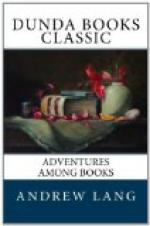Mr. Hutton, from whose “Literary Essays” I borrow Poe’s opinion, says: “Poe boldly asserted that the conspicuously ideal scaffoldings of Hawthorne’s stories were but the monstrous fruits of the bad transcendental atmosphere which he breathed so long.” But I hope this way of putting it is not Poe’s. “Ideal scaffoldings,” are odd enough, but when scaffoldings turn out to be “fruits” of an “atmosphere,” and monstrous fruits of a “bad transcendental atmosphere,” the brain reels in the fumes of mixed metaphors. “Let him mend his pen,” cried Poe, “get a bottle of visible ink, come out from the Old Manse, cut Mr. Alcott,” and, in fact, write about things less impalpable, as Mr. Mallock’s heroine preferred to be loved, “in a more human sort of way.”
Hawthorne’s way was never too ruddily and robustly human. Perhaps, even in “The Scarlet Letter,” we feel too distinctly that certain characters are moral conceptions, not warmed and wakened out of the allegorical into the real. The persons in an allegory may be real enough, as Bunyan has proved by examples. But that culpable clergyman, Mr. Arthur Dimmesdale, with his large, white brow, his melancholy eyes, his hand on his heart, and his general resemblance to the High Church Curate in Thackeray’s “Our Street,” is he real? To me he seems very unworthy to be Hester’s lover, for she is a beautiful woman of flesh and blood. Mr. Dimmesdale was not only immoral; he was unsportsmanlike. He had no more pluck than a church-mouse. His miserable passion was degraded by its brevity; how could he see this woman’s disgrace for seven long years, and never pluck up heart either to share her shame or peccare forliter? He is a lay figure, very cleverly, but somewhat conventionally made and painted. The vengeful husband of Hester, Roger Chillingworth, is a Mr. Casaubon stung into jealous anger. But his attitude, watching ever by Dimmesdale, tormenting him, and yet in his confidence, and ever unsuspected, reminds one of a conception dear to Dickens. He uses it in “David Copperfield,” where Mr. Micawber (of all people!) plays this trick on Uriah Heep; he uses it in “Hunted Down”; he was about using it in “Edwin Drood”; he used it (old Martin and Pecksniff) in “Martin Chuzzlewit.” The person of Roger Chillingworth and his conduct are a little too melodramatic for Hawthorne’s genius.
In Dickens’s manner, too, is Hawthorne’s long sarcastic address to Judge Pyncheon (in “The House of the Seven Gables"), as the judge sits dead in his chair, with his watch ticking in his hand. Occasionally a chance remark reminds one of Dickens; this for example: He is talking of large, black old books of divinity, and of their successors, tiny books, Elzevirs perhaps. “These little old volumes impressed me as if they had been intended for very large ones, but had been unfortunately blighted at an early stage of their growth.” This might almost deceive the elect as a piece of the true Boz. Their widely different talents did really intersect each other where the perverse, the grotesque, and the terrible dwell.




